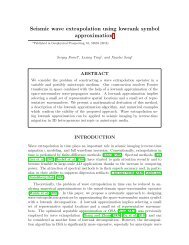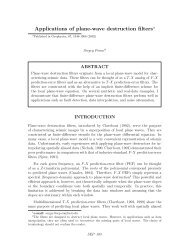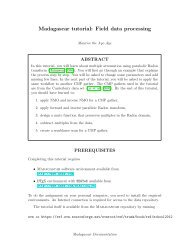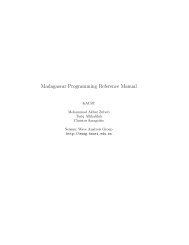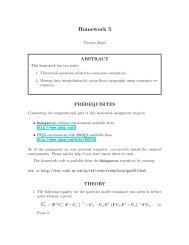Using IWAVE - Madagascar
Using IWAVE - Madagascar
Using IWAVE - Madagascar
Create successful ePaper yourself
Turn your PDF publications into a flip-book with our unique Google optimized e-Paper software.
2<br />
• flexible specification of PML absorbing or pressure-release boundary conditions<br />
on all faces of the simulation cube;<br />
• arbitrary source and receiver locations, and flexible point and array source specification<br />
including simultaneous source modeling (random, plane-wave,...)<br />
• standard input and output data formats (SEGY, RSF)<br />
An isotropic elastic modeling application with similar features, and built around the<br />
same core framework, has been developed and will be included in a forthcoming<br />
release.<br />
The primary purpose of this short paper is to illustrate the use of <strong>IWAVE</strong> to<br />
calculate synthetic acoustic seismograms. To that end, the paper describes a simple<br />
application - 2D synthetic seismogram generation over a simple structural model of the<br />
sedimentary column - and provides a set of demonstration examples (“demos”) which<br />
the reader may reproduce, along with complete annotation of the files needed for job<br />
specification and sample graphics derived from the results (as well as commands to<br />
produce these graphics).<br />
A secondary purpose is to supply the user with the means to independently verify<br />
some of the claims in the paper by Symes and Vdovina (2009), namely the existance<br />
of an error component in synthetic data derived from strongly heterogeneous models,<br />
in addition to the well-known grid dispersion error. The examples presented here are<br />
essentially the same as those presented in that paper. By installing <strong>IWAVE</strong> and running<br />
the demonstrations described here, the reader may reproduce the computational<br />
content of (Symes and Vdovina, 2009).<br />
<strong>IWAVE</strong> is both a standalone application, and a component of the <strong>Madagascar</strong> software<br />
suite (Fomel, 2009) The application package and the examples discussed here<br />
(and indeed this paper itself) may be built either independently, or within <strong>Madagascar</strong>,<br />
as explained in detail below.<br />
<strong>IWAVE</strong> was used in a quality control role in the SEAM Phase I project - see<br />
Fehler and Keliher (2011) for an account, including discussion of the many difficulties<br />
of large scale numerical simulation of seismograms.<br />
The internal details of <strong>IWAVE</strong> are not discussed here, except insofar as is necessary<br />
to explain the use of the main commands. Symes et al. (2011) briefly describe<br />
the structure of the <strong>IWAVE</strong> framework, with emphasis on its object-oriented design<br />
and the resulting mechanisms for coupling modeling with optimization packages to<br />
produce inversion applications. The <strong>IWAVE</strong> project web page (Terentyev et al., 2012)<br />
provides extensive reference material, and further information about the design.<br />
The paper begins with a brief review of the system of partial differential equations<br />
solved (approximately) by <strong>IWAVE</strong>’s acoustic application, and the choice of finite<br />
difference method. The following section presents the examples of Symes and Vdovina<br />
(2009), along with some additional examples based on the same distribution of




